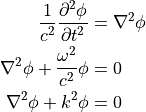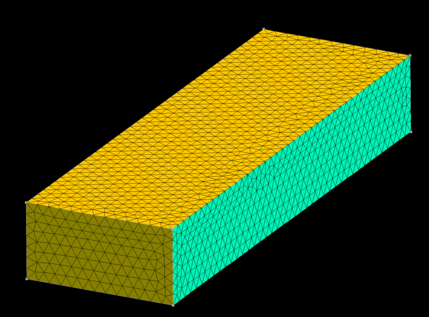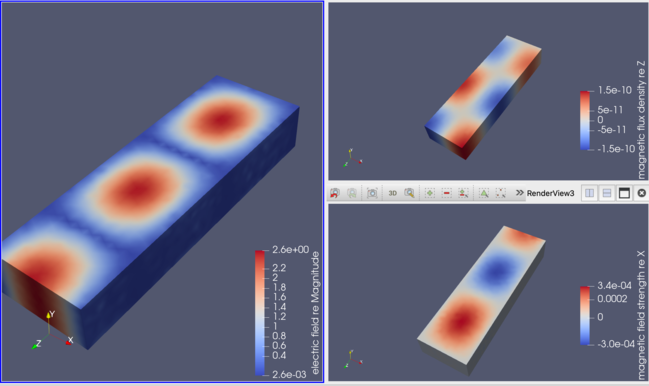矩形導波管解析 ( Vectorial Helmholtz Equation )¶
矩形導波管を例として、電磁波のFEM解析手法について述べる.
電磁波解析には、時系列的な解析手法(FDTD)と周波数解析(単一周波数の振幅分布を求める)手法がある.
波動解析全般において、勿論、波動方程式が成立する. Maxwell 方程式も例外ではない.波動方程式の Fourier 変換は、Helmholtz 方程式となる.

周波数空間における波動伝搬の解析は、Helmholtz 方程式を解けば良い. Helmholtz 方程式は、 Poisson 方程式の非線形解析型であるので、FEMを用いて解ける.
上記、スカラー関数での議論は、電磁波の3次元ベクトルの場合にも適用できる.電磁波の場合、前項で示したベクトル型 Helmholtz 方程式( Vectorial Helmholtz Equation )となる.
問題設定 / メッシュ / 境界条件¶
問題設定¶
矩形導波管( 矩形断面長さ: a ,b 、長さ L )内を伝搬する電磁波を考える.
電磁波の周波数は、
 .
.解析対象は TE10 モード
パラメータ設定
矩形断面
 を考えてみる. ( 典型例として、
を考えてみる. ( 典型例として、  としている.)
としている.)
メッシュ¶
メッシュ生成用スクリプトファイルを以下に示す.
1import os, sys
2import numpy as np
3import gmsh_api.gmsh as gmsh
4
5# ------------------------------------------------- #
6# --- [1] initialization of the gmsh --- #
7# ------------------------------------------------- #
8gmsh.initialize()
9gmsh.option.setNumber( "General.Terminal", 1 )
10gmsh.model.add( "model" )
11
12# ------------------------------------------------- #
13# --- [2] initialize settings --- #
14# ------------------------------------------------- #
15ptsDim , lineDim , surfDim , voluDim = 0, 1, 2, 3
16pts , line , surf , volu = {}, {}, {}, {}
17ptsPhys, linePhys, surfPhys, voluPhys = {}, {}, {}, {}
18x_, y_, z_, lc_, tag_ = 0, 1, 2, 3, 4
19
20# ------------------------------------------------- #
21# --- [3] Modeling --- #
22# ------------------------------------------------- #
23
24import nkGmshRoutines.generate__quadShape as gqs
25
26lc_inner = 0.0300
27
28wg_a = 0.3810
29wg_b = 0.1905
30wg_L = 1.2138478633282366
31
32x1_wg_i = [ 0.0, 0.0, 0.0 ]
33x2_wg_i = [ wg_a, 0.0, 0.0 ]
34x3_wg_i = [ wg_a, wg_b, 0.0 ]
35x4_wg_i = [ 0.0, wg_b, 0.0 ]
36
37ex_delta = [ 0.0, 0.0, wg_L ]
38
39ret1 = gqs.generate__quadShape( lc=lc_inner, defineVolu=True, extrude_delta=ex_delta, \
40 x1=x1_wg_i , x2=x2_wg_i, \
41 x3=x3_wg_i , x4=x4_wg_i, recombine=False )
42
43
44# ------------------------------------------------- #
45# --- [4] attribute physical number --- #
46# ------------------------------------------------- #
47
48import nkGmshRoutines.load__physNumTable as pnt
49pnt.load__physNumTable( inpFile="physNumTable.dat", line=line, surf=surf )
50
51
52# ------------------------------------------------- #
53# --- [5] post process --- #
54# ------------------------------------------------- #
55gmsh.model.occ.synchronize()
56gmsh.model.mesh.generate(3)
57gmsh.write( "model.geo_unrolled" )
58gmsh.write( "model.msh" )
59gmsh.finalize()
60
用いたメッシュを以下に示す.

境界条件¶
境界条件としては、電磁波の入射境界 ( -z 境界 )と出射境界 ( +z 境界 )、及び、導体境界からなる.
elmer 入力ファイル ( .sif ファイル )¶
elmer用の入力ファイルを以下に示す.
1
2! ========================================================= !
3! === waveguide simulation === !
4! ========================================================= !
5
6! ------------------------------------------------- !
7! --- [1] Global Simulation Settings --- !
8! ------------------------------------------------- !
9
10Check Keywords "Warn"
11
12Header
13 Mesh DB "." "model"
14 Include Path ""
15 Results Directory ""
16End
17
18Simulation
19 Coordinate System = String "Cartesian"
20 Coordinate Mapping(3) = 1 2 3
21
22 Simulation Type = Steady
23 Steady State Max Iterations = Integer 1
24 Output Intervals = Integer 1
25 Timestepping Method = BDF
26 BDF Order = Integer 1
27
28 Solver Input File = "waveguide.sif"
29 Output File = "waveguide.dat"
30 Post File = "vectorhelmholtz.vtu"
31End
32
33Constants
34 ! Do NOT write down - permeability - an error somehow occurs...!!!
35 ! Permeability of Vacuum = 1.2566e-06
36 ! Permittivity of Vacuum = 8.8542e-12
37End
38
39! ------------------------------------------------- !
40! --- [2] Body & Material Settings --- !
41! ------------------------------------------------- !
42
43Body 1
44 Target Bodies(1) = 301
45 Name = "wavepath"
46
47 Equation = 1
48 Material = 1
49 Initial Condition = 1
50End
51
52Material 1
53 Name = "Air"
54 Electric Conductivity = 0.0
55 Relative Permittivity = 1.0
56 Relative Permeability = 1.0
57End
58
59
60! ------------------------------------------------- !
61! --- [3] Equation & Solver Settings --- !
62! ------------------------------------------------- !
63
64$ freq = 5.001e8
65$ wg_a = 0.3810
66$ wg_b = 0.1905
67$ wg_L = 1.2138478633282366
68$ wAmp = 1.0
69
70$ mmode = 1
71$ nmode = 0
72$ epsil = 8.854e-12
73$ mu = 4.0*pi*10^-7
74$ c0 = 1.0 / sqrt( epsil * mu )
75$ omega = 2.0 * pi * freq
76$ k0 = omega / c0
77$ kx = mmode * pi / wg_a
78$ ky = nmode * pi / wg_b
79$ kc = sqrt( kx^2 + ky^2 )
80$ beta0 = sqrt( k0^2 - kc^2 )
81$ Acoef = omega * mu * kx * wAmp / kc^2
82$ sigma = 5.e3
83$ Zp_m = sqrt( 0.5 * mu * omega / sigma )
84$ alp_m = omega * mu / Zp_m
85! alpha_for_metal = -i / ( 1 - i ) * alp_m = ( 1-i ) / 2 * alp_m ...> set this value as B.C.
86
87
88Equation 1
89 Name = "waveguide_EMpath"
90 Active Solvers(3) = 1 2 3
91 Angular Frequency = Real $omega
92End
93
94
95Solver 1
96 Equation = "VectorHelmholtzEquation"
97 Procedure = "VectorHelmholtz" "VectorHelmholtzSolver"
98 Variable = E[E re:1 E im:1]
99 Exec Solver = String "Always"
100
101 Use Piola Transform = Logical True
102 Optimize Bandwidth = Logical True
103 Linear System Symmetric = Logical False
104 Linear System Scaling = Logical True
105 Linear System Solver = String "Iterative"
106 ! -- Method :: ( BiCGStabl / gmres ) -- !
107 Linear System Iterative Method = String "gmres" ! or "BiCGStabl"
108 ! Linear System Iterative Method = String "BiCGStabl" ! or "gmres"
109 ! BiCGstabl polynomial degree = Integer 4
110
111 Steady State Convergence Tolerance = Real 1.0e-9
112
113 Linear System Preconditioning = String "vanka"
114 Linear System ILUT Tolerance = Real 3.0e-3
115 Linear System Max Iterations = Integer 5000
116 Linear System Convergence Tolerance = Real 1.0e-9
117 Linear System Abort Not Converged = Logical False
118 Linear System Residual Output = Integer 8
119 Linear System Preconditioning Damp Coefficient = Real 0.0
120 Linear System Preconditioning Damp Coefficient im = Real 1.0
121
122End
123
124
125Solver 2
126 Equation = "calcFields"
127 Procedure = "VectorHelmholtz" "VectorHelmholtzCalcFields"
128 ! Field Variable = String "E"
129 Exec Solver = String "Always"
130 Use Piola Transform = Logical True
131 Optimize Bandwidth = Logical False ! "True"
132 Linear System Symmetric = Logical False
133 Linear System Scaling = Logical True
134 Linear System Solver = String "Iterative"
135 Linear System Iterative Method = String "BiCGStabl" ! "CG"
136 BiCGstabl polynomial degree = Integer 4
137
138 Calculate Elemental Fields = Logical False
139 Calculate Magnetic Field Strength = Logical True
140 Calculate Electric Field = Logical True
141 Calculate Poynting Vector = Logical True
142 Calculate Magnetic Flux Density = Logical True
143 Calculate Div of Poynting Vector = Logical True
144
145 Steady State Convergence Tolerance = 1.0e-9
146 Exported Variable 1 = -dofs 3 Eref_re
147
148 Linear System Preconditioning = String "None"
149 Linear System ILUT Tolerance = Real 1e-5
150 Linear System Max Iterations = Integer 5000
151 Linear System Convergence Tolerance = Real 1.0e-9
152 Linear System Abort Not Converged = Logical False
153 Linear System Residual Output = Integer 10
154 Linear System Preconditioning Damp Coefficient = Real 0.0
155 Linear System Preconditioning Damp Coefficient im = Real 1.0
156
157End
158
159
160Solver 3
161 Equation = "SaveScalars"
162 Procedure = "SaveData" "SaveScalars"
163 FileName = "dat/waveguide_scalars.dat"
164End
165
166
167! ------------------------------------------------- !
168! --- [4] Body Forces / Initial Conditions --- !
169! ------------------------------------------------- !
170
171Initial Condition 1
172 Eref_re 1 = Real MATC "0.0"
173 Eref_re 2 = Variable coordinate 1, coordinate 3
174 Real MATC "sin(kx*tx(0))*( sin( beta0*tx(1) ) - sin( -beta0*tx(1)+2.0*beta0*wg_L) )"
175 Eref_re 3 = Real MATC "0.0"
176
177 ! Eref_re 2 = Variable coordinate 1, coordinate 3
178 ! Real MATC "( -1.0 )*Acoef*sin( kx*tx(0) )*sin( beta0*tx(1) )"
179
180End
181
182
183! ------------------------------------------------- !
184! --- [5] Boundary Conditions --- !
185! ------------------------------------------------- !
186
187Boundary Condition 1
188
189 Target Boundaries(1) = 201
190 Name = "inport"
191
192 ! ------------------------------------ !
193 ! -- Port Feed condition -- !
194 ! ------------------------------------ !
195 ! -- alpha = i \beta -- !
196 ! -- g = 2 i \beta * ( n x E ) x n -- !
197 ! ------------------------------------ !
198 Electric Robin Coefficient = Real $ 0.0
199 Electric Robin Coefficient im = Real $ beta0
200 Magnetic Boundary Load 2 = Variable Coordinate 1
201 Real MATC "-2.0*beta0*k0/kc*sin(kx*tx)"
202 ! Real MATC "(-2.0)*beta0*Acoef*sin(kx*tx)"
203
204End
205
206
207Boundary Condition 2
208
209 Target Boundaries(1) = 202
210 Name = "outport"
211
212 ! ------------------------------------ !
213 ! -- PEC condition -- !
214 ! ------------------------------------ !
215 ! -- perfect conductor ( nxE = 0 ) -- !
216 ! -- E re {e} = 0.0 -- !
217 ! -- E im {e} = 0.0 -- !
218 ! ------------------------------------ !
219 ! E re {e} = 0.0
220 ! E im {e} = 0.0
221
222 ! ------------------------------------ !
223 ! -- Impedance condition -- !
224 ! ------------------------------------ !
225 ! -- alpha = i \beta -- !
226 ! -- g = 2 i \beta * ( n x E ) x n -- !
227 ! ------------------------------------ !
228 ! Electric Robin Coefficient = Real $ ( 0.5 ) * alp_m
229 ! Electric Robin Coefficient im = Real $ ( -0.5 ) * alp_m
230 ! Magnetic Boundary Load 2 = Real $ 0.0
231 ! Magnetic Boundary Load 2 im = Real $ 0.0
232
233
234 ! ------------------------------------ !
235 ! -- Neumann condition -- !
236 ! ------------------------------------ !
237 ! -- alpha = 0.0 -- !
238 ! -- g = 0.0 -- !
239 ! ------------------------------------ !
240 Electric Robin Coefficient = Real $ 0.0
241 Electric Robin Coefficient im = Real $ 0.0
242 Magnetic Boundary Load 2 = Real $ 0.0
243 Magnetic Boundary Load 2 im = Real $ 0.0
244
245End
246
247
248Boundary Condition 3
249
250 Target Boundaries(1) = 203
251 Name = "sidewall"
252
253 ! ------------------------------------ !
254 ! -- PEC condition -- !
255 ! ------------------------------------ !
256 ! -- perfect conductor ( nxE = 0 ) -- !
257 ! -- E re {e} = 0.0 -- !
258 ! -- E im {e} = 0.0 -- !
259 ! ------------------------------------ !
260 E re {e} = 0.0
261 E im {e} = 0.0
262
263 ! ------------------------------------ !
264 ! -- Impedance condition -- !
265 ! ------------------------------------ !
266 ! -- alpha = i \beta -- !
267 ! -- g = 2 i \beta * ( n x E ) x n -- !
268 ! ------------------------------------ !
269 ! Electric Robin Coefficient = Real $ ( 0.5 ) * alp_m
270 ! Electric Robin Coefficient im = Real $ ( -0.5 ) * alp_m
271 ! Magnetic Boundary Load 2 = Real $ 0.0
272 ! Magnetic Boundary Load 2 im = Real $ 0.0
273
274
275 ! ------------------------------------ !
276 ! -- Neumann condition -- !
277 ! ------------------------------------ !
278 ! -- alpha = 0.0 -- !
279 ! -- g = 0.0 -- !
280 ! ------------------------------------ !
281 ! Electric Robin Coefficient = Real $ 0.0
282 ! Electric Robin Coefficient im = Real $ 0.0
283 ! Magnetic Boundary Load 2 = Real $ 0.0
284 ! Magnetic Boundary Load 2 im = Real $ 0.0
285
286End
287
重要命令は、以下の通りである.
(l.33-37) constants 内で自然な真空の透磁率・誘電率を指定してはいけない.何故かはわからないが、バグが生じてしまい、正しく計算できなくなる.
(l.64-85) パラメータ設定. $記号を用いて、elmer内部で変数を定義することができる.
(l.91) 解析対象とする角周波数.
(l.97,l.127) VectorHelmholtzソルバーを用いるという指示文.
(l.171-180) 比較対象とする解析解を initial condition として定義.内部では変数が用いられないからこの変数は変化しない.
(l.187-204) inport (風上側境界の電磁場指定).
 として、境界面での電場分布を与える.
として、境界面での電場分布を与える.(l.207-245) outport ( 風下側境界の電磁場指定 ).
 として、Neumann 境界条件を課す.
として、Neumann 境界条件を課す.(l.248-286) 導波管壁の境界条件指定.
 として、 Dirichlet 境界条件を課す.
として、 Dirichlet 境界条件を課す.

